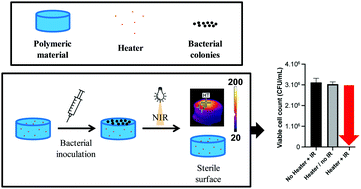Safe near infrared light for fast polymers surface sterilization using organic heaters†
Abstract
Sterilization approaches using UV radiation (e.g. 254 nm), dry heat and moist heat have been widely reported in the literature. A breakthrough approach is presented here. In the present study, we proposed a most environmentally friendly approach for polymer surface sterilization using safe Near-InfraRed (NIR) light to produce a powerful photothermal effect using organic NIR dyes as heaters. Markedly, well selected organic dyes strongly absorbing in the NIR range have been used as stimuli responsive compounds. When excited upon NIR light, these heaters release the light energy to their surrounding environment in the form of heat. In this work, trimethylolpropane triacrylate (TMPTA) based polymers, used as benchmark materials for polymers or coatings, could reach high temperatures (>120 °C) in a very short time scale (∼30 s). Using heater-containing polymers, sterilization experiments showed very good results with total eradication of bacteria (Escherichia coli) after only 2 min of NIR irradiation (2.55 W cm−2). These results suggest that short irradiation flashes could be enough to sterilize contaminated surfaces. Moreover, irradiation tests have been performed on three NIR heaters in the NIR-II range (1000–1700 nm) for a better in-depth penetration. Indeed, almost 200 °C could be reached by polymers in less than 1 min of NIR irradiation (2.5 W cm−2). Therefore, NIR LED irradiation of heater-containing polymers constitutes here a robust, transportable and safe sterilization method.



 Please wait while we load your content...
Please wait while we load your content...